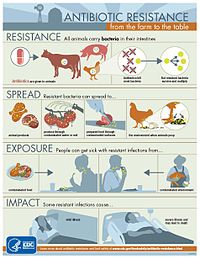
Photo from wikipedia
Antimicrobial resistance (AMR) is problematic worldwide, and due to the loss of efficiency of many antibiotics, the pressure to discover alternative antimicrobial molecules has increased. Soil harbors a great biodiversity… Click to show full abstract
Antimicrobial resistance (AMR) is problematic worldwide, and due to the loss of efficiency of many antibiotics, the pressure to discover alternative antimicrobial molecules has increased. Soil harbors a great biodiversity and biomass of microorganisms, and many antibiotics are produced by soil microbiota. Therefore, soil is a promising reservoir to find new antimicrobial agents. In this respect, novel pedagogical strategies regarding the AMR global crisis have recently been developed in different countries worldwide. Highlighted is the service-learning project “MicroMundo” integrated in a global Citizen Science project called “Tiny Earth”. Hence, the present work aimed at determining the antimicrobial activity of soil bacteria, the biodiversity of the selected isolates as putative antimicrobial producers, and their antibiotic resistance profile. Moreover, through the MicroMundo project, we tried to illustrate the relevant link between science and education and the benefits of implementing service-learning methodologies to raise awareness of the AMR problem and to contribute to the search for new alternatives. A total of 16 teachers, 25 university students and 300 secondary school students participated in the search for antimicrobial activity on a collection of 2600 isolates obtained from a total of 130 soil samples analysed. In total, 132 isolates (5% of total tested) were selected as potential antimicrobial producers when two indicator bacteria were used (Escherichia coli and Staphylococcus epidermidis); the most frequent genus among these isolates was Bacillus, followed by Pseudomonas, Paenibacillus and Serratia. The antimicrobial activity (AA) of the 132 potential antimicrobial producers was studied in a second step against 15 indicator bacteria (of six genera and thirteen species, including relevant pathogens). Of the 132 potentially producing bacteria, 32 were selected for further characterization. In this respect, 18 isolates showed low AA, 12 isolates were considered as medium producers, and 2 highly antimicrobial-producing isolates were found (Brevibacillus laterosporus X7262 and Staphylococcus hominis X7276) showing AA against 80% of the 15 indicators tested. Moreover, 48% of the antimicrobial-producing bacteria were susceptible to all antibiotics tested. Due to citizen science, antimicrobial-producing bacteria of great interest have been isolated, managing to raise awareness about the problem of AMR.
Journal Title: Antibiotics
Year Published: 2022
Link to full text (if available)
Share on Social Media: Sign Up to like & get
recommendations!